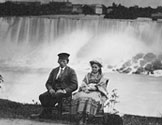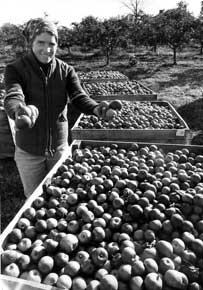

|
||||||||||||||||||||||||||||||||||||||||||
|
| ||||||||||||||||||||||||||||||||||||||||||
 |
 |
 |
 |
 Picking Niagara County Apples  Apple picking in Niagara County today is quite a bit different than the process used in by-gone days. Apple harvesting today on dwarf trees with modern tractors to move product from tree to processor has replaced a lengthy method used in the 19th century. Melvin Shaver, a native of Somerset and descendant of the Barker and Haight families, wrote of his recollections of apple harvest time in 1855. He noted that the process was made much more difficult by the height of the apple trees. Standard tree height exceeded thirty feet and those picking the crop usually worked from 35-foot ladders in order to reach some of the fruit. It was also an unwritten law that once a picker began to pick; he would not leave a tree until all the apples were off. The first step in the procedure actually began with picking up fruit that had blown off and landed near the base of the tree. These “windfalls” were collected and taken to evaporators where they would be dried and usually shipped to foreign markets. Once the ground was cleared of windfalls, a load of straw was brought into the orchard and placed in convenient places in the orchard. The straw became a “nest” on which the picked apples would be placed for later sorting and grading. Then came the ladders and picking baskets, which were usually of hardwood staves with a wooden hoop handle. The baskets held about a half-bushel of fruit. The picker would ascend the ladder, basket in hand, and once in place, fasten the basket to the ladder with a metal hook. When the basket was full, the fruit was carried down the ladder, dumped on the straw, and the ladder climbed again and again for more fruit. This continued until all of the fruit was picked and then the ground under the trees was once again cleared of drops. The next step involved the grading and sorting of the apples in a process called “barreling.” There was no mechanical equipment to grade the fruit, so it was sorted by hand into two grades: firsts and seconds. This was accomplished by getting down on the ground and sorting through the fruit that was resting in the pile of straw. All of this fun continued for about 12 hours per day and six days per week, for which the average wage was $1.25 per day. Shaver remarked that in the 1850s, there were no aphis or other insects in Niagara County. Spraying at that time was unknown. Aphis entered the region at a later date, arriving from Asia. An orchard in Lewiston was first affected and soon all of the trees in the area died and later, it became necessary to spray all of the trees in the county. Douglas Farley, Director Erie Canal Discover Center 24 Church St. Lockport NY 14094 716.439.0431 CanalDiscovery@aol.com www.NiagaraHistory.org |